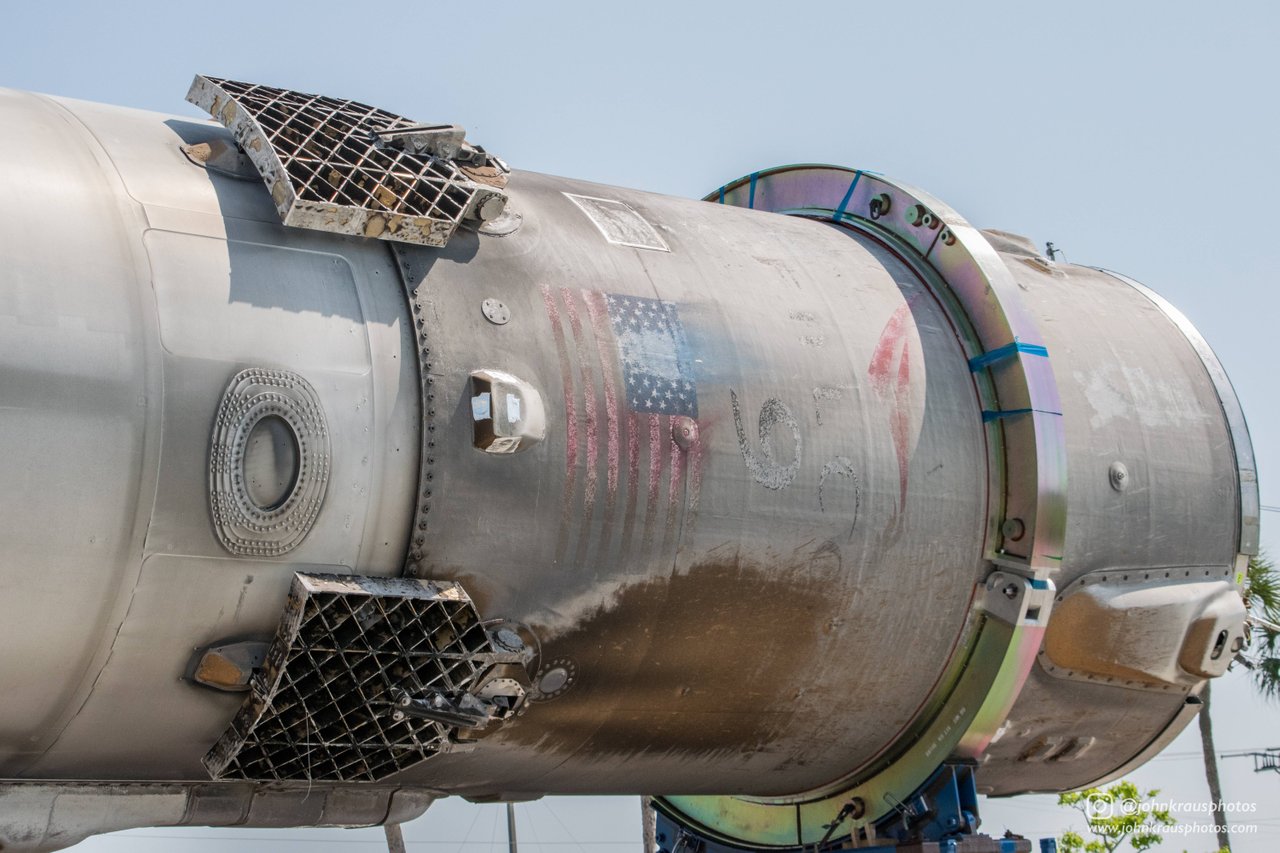I was always intrigued about aviation and space travel and after I got to work in the Aviation Industry for over 10 years, my greatest regret was not to have aimed even higher for aerospace. I am a total geek for rockets and understanding what I consider to be the greatest achievement of man to date. We should be proud of those men and women who write our history of evolution.
Tomorrow is a big day for rocket science. A private company will send a satellite to Mars with its own rocket. The Falcon Heavy will have its maiden voyage launch window on 6th of February. It will be the most powerful operational rocket by a factor of two. This means that we will again have a rocket to replace the Space Shuttle and its operational capabilities.

Software rendering of tomorrow's launch since it's the first of this rocket.
A sense of size
Comparing the Falcon Heavy to the other historical rockets brings some positioning into the talk.
With a height of 70m ( 230 ft) and a diameter of 12.2m ( 40ft) it is bigger than most of its competitors.
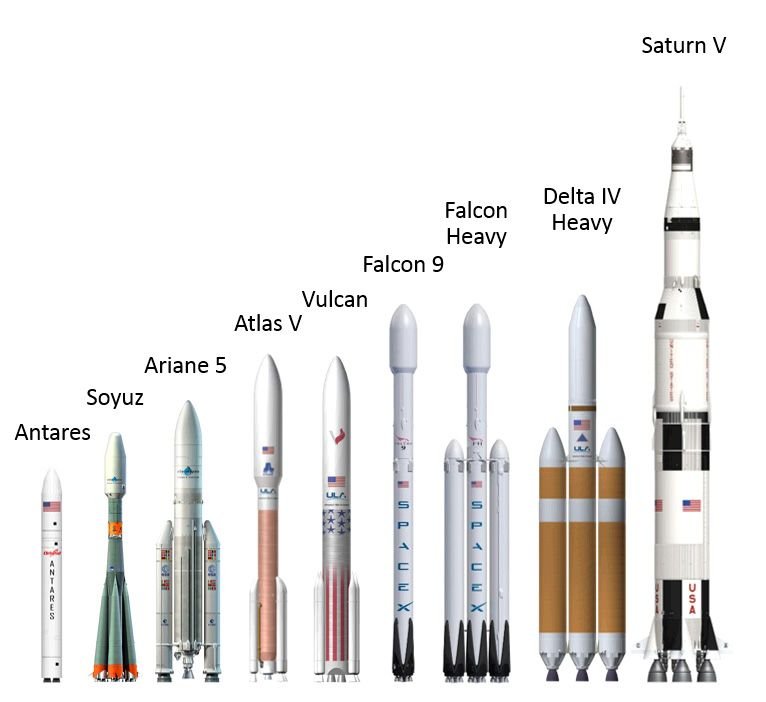
Image is courtesy of Wired Magazine 1
The only marginally bigger (3%) operational rocket, the Delta IV Heavy, which is the current lifting workhorse for the United Launch Alliance, used to lift the heaviest satellites into space has greatly inferior payload lifting to Low Earth Orbit: only 35% of Falcon Heavy's load.
The Saturn V rocket which overshadows everything else in the comparison is the spacecraft that took the Apollo missions to the Moon and is by far the biggest rocket ever launched.
When comparing the lifting capabilities of the Falcon Heavy we can see that if successfully launched it will be able to send more cargo to Low Earth Orbit than any other rocket in use today.

But can we trust this private company?
SpaceX was founded in 2002 by Elon Musk, who rose to fame after building up the Tesla brand of electric cars, practically bringing the dream of owning an electric car to reality. He later said that after selling his shares in PayPal he wanted to spend half of his money in doing something that will allow him to have fun but also to help mankind. He set low expectations but they were rewarded after a series of failed tests on Falcon 1, when they finally managed to get the rocket in space.
So it looks like there is history to this success now and they tested and retested their engines to ensure everything will go according to plan. The Falcon 9 was a bigger version of the Falcon 1 but it used the same engines. This was the main research craft for SpaceX and it allowed them to research the first few blocks of the Merlin Engine. Using RP-1 and LOX (liquid oxygen) in a gas-generator power cycle, the engine came in two variants, the Booster Engine and the Vacuum Engine.
To streamline the development window they didn't spend a lot of time researching two types of engines but instead focused on developing a single engine with only minor differences. If there is interest I can write an article only on this, and get much more technical :P.
You can clearly see the development results in the next table, starting from the Merlin 1C's thrust of 3807 kN all the way to the 7607 kN. The values are per engine and Falcon 9 is named "9" after the number of 9 Merlin Engines present on it.
The evolution is also visible in terms of payload lift: 22800 vs 8500. This is more than double, I like those figures since they make the Falcon 9 a serious contender for the National Space Agencies, which are benefiting from huge amounts of state funds.
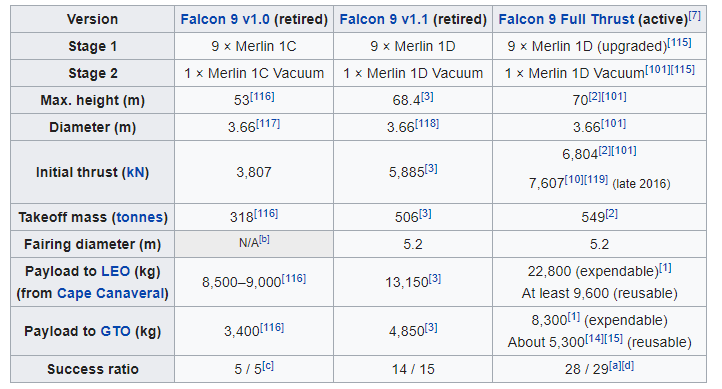
Table courtesy of Wikipedia
But why invest so much in an engine that gets 5 minutes of use then burns up at reentry?
Well, this is where the SpaceX vision was pioneering. While NASA and Space Launch Alliance tried to salvage boosters and first stages from their own rockets, the result was not that economical, refurbishing a booster after splashing down in the ocean is a tricky operation and costly nonetheless.
SpaceX designed a rocket that can return to the launchpad by itself
Indeed, this Merlin engine was very expensive to develop and build so why throw it all away? Or why get it wet and do expensive anti-corrosion treatments after each flight.
The physics works in Falcon 9's advantage, as after its use it's basically an expensive empty vessel falling out of the sky.
What if a control system would be designed and used so that the landing is done smoothly? Instant re-usability. This could also come in handy when landing on planets without much or any atmosphere, like Mars. Why not test Mars landings on Earth?
SpaceX did exactly that already, starting in 2013 and perfecting it until using it in 2015.
This above video is of one of the last tests before final implementation.
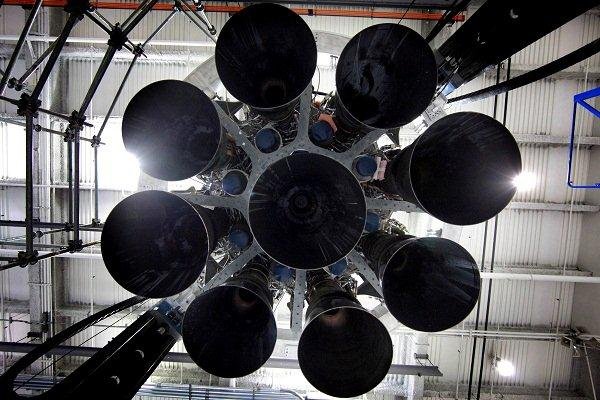
The thrust direction is being controlled via the central engine gimbal and the other 8 engines are fixed. This allows fine tuning of the landing and if done just a few seconds from landing has the power to stop the empty booster within seconds.
The maneuver is done at the last calculated possible moment to conserve energy and not lose it by fighting gravity.
To maneuver the spacecraft from stage separation to landing, the rocket uses grid fins and cold gas thrusters. Mobile and computer controlled grid fins deploy and stabilize the rocket while traveling at Mach Speeds (greater than the speed of sound) and sometimes they get a beating upon reentry because they have to stick out of the rocket by design.
Where does the Falcon Heavy come in? You only talked about Falcon 9!
As you already saw that the secret of being a successful commercial company is to reuse the common elements which can be manufactured on a single production line, of course that the Falcon Heavy is designed from the success of Falcon 9. In fact it actually consists of 3 Falcon 9 Boosters, with a second stage and the payload inside its fairing. This means 27 engines just to the orbit. The second stage comes with its own Merlin Vacuum Engine. This is another reason why I consider SpaceX innovative.
The Falcon Heavy had a long series of delays, due to technology change and safety. It was originally scheduled for 2013 and subsequently delayed until now.
The launch will take place on the same launch pad that saw the launch of the Apollo Moon mission which is leased to SpaceX by NASA.
Watch the simulation. You know you want to :D
Much of this was already done, SpaceX lands its own boosters since 2016, and has a track record of doing it safely and in one piece, and on Feb.6th the same thing will happen, just that the first two Boosters will land back at Cape Canaveral while the middle Booster will land on the droneship
Droneships are already used by SpaceX to land Boosters so this will be pretty usual for them.
Yes, the rocket lands on that platform somewhere in the Atlantic Ocean after coming in hot from space. Amazing time to live isn't it?

Will it really be sending Elon Musk's Tesla Roadster to Mars Orbit?
Of course! Because it's a test flight nobody would risk losing an actual satellite and Elon Musk's humor kicked in. Also as a publicity stunt, humankind will send a car playing music to Mars Orbit
Now to debunk it a little, the Roadster will not make it to the actual Martian Orbit but instead it will reach Mars Orbit around the Sun. There are many factors which are taken into account, such as aphelion of Mars, the phase of the planets which give what is called Mars Launch Window. Plus there is a signed agreement which prohibits further radio pollution around the planetary bodies that pose a great interest to science in the near future.
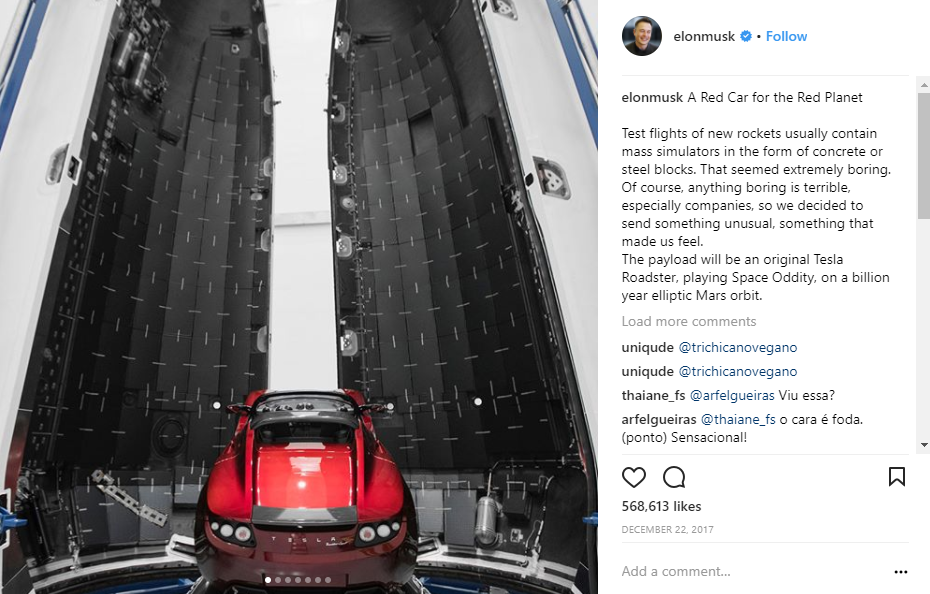
This is not a rendering, it's the actual car and the fairing :)
According to the whitepaper they published last year - Making Humans a Multiplanetary Species, the car will get there in 110 days give or take (depending on DeltaV budget , the positions of the both planets and the specifications of the Hoffman maneuver they will use).
I am sure they will let us know soon after the successful takeoff.
I can supply more technical details for whoever is interested, I intentionally kept it simple so that it might help anyone in the community to learn more about this incredible feat of engineering. And of course that if you have questions I am open to discussion.
As usual the launch will be broadcast on http://www.spacex.com/webcast. It appears that from the start of my writing this article until now it has come online and counting the hours.
Enjoy your week!
Sources:
Text is mine
Images are from SpaceX.com unless otherwise specified
A screen capture of Elon Musk's Instagram post.
If you like it don't forget to share the joy of the engineering achievement. This must be promoted instead of the false examples the world keeps throwing at us through news.



